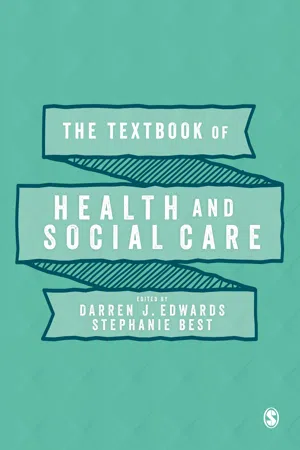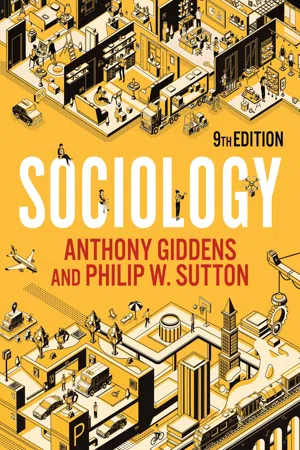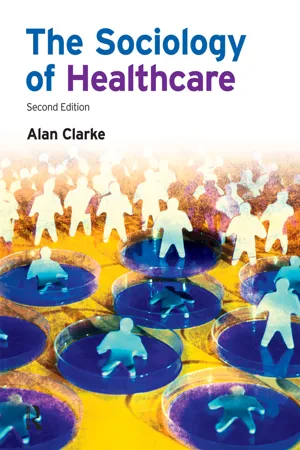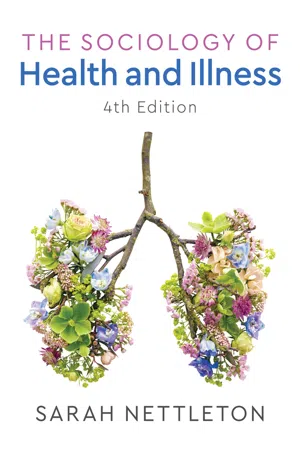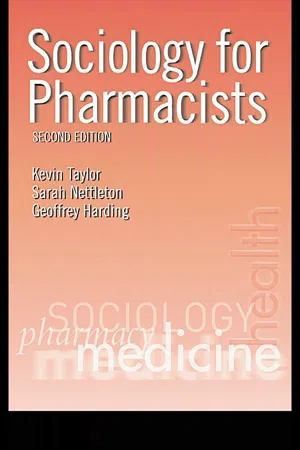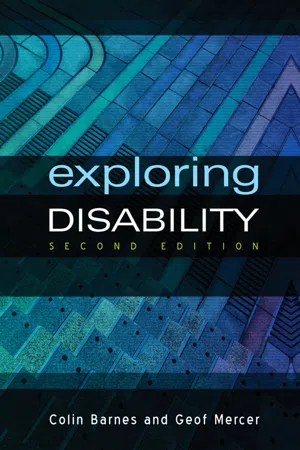Social Sciences
Social Construction of Health and Illness
The social construction of health and illness refers to the idea that perceptions of health and illness are shaped by social, cultural, and historical factors. It emphasizes that what is considered healthy or pathological is not solely determined by biological or medical factors, but is also influenced by societal norms, values, and power dynamics. This perspective highlights the importance of understanding health and illness within broader social contexts.
Written by Perlego with AI-assistance
Related key terms
10 Key excerpts on "Social Construction of Health and Illness"
- eBook - ePub
- Darren Edwards, Stephanie Best, Darren Edwards, Stephanie Best(Authors)
- 2020(Publication Date)
- SAGE Publications Ltd(Publisher)
Chapter 1 Sociology of Health and Illness Ashley FrawleyOverview
This chapter introduces the sociology of health and illness, first by considering the meaning of the ‘sociological imagination’ and associated importance of the concept of context to understanding human social life. It then discusses three contexts of health: socio-economic, institutional/professional and cultural. Within these contexts a number of key issues in the sociology of health and illness are considered: the social determinants of health, health inequalities, challenges to medical authority, social construction and health panics, medicalisation and growing cultural preoccupations with health risks.Learning Outcomes
By the end of this chapter you will be able to:- Define the ‘sociological imagination’ and its relationship to the concept of context
- Discuss the relationship between socio-economic context and health inequalities
- Critically examine different explanations of health inequalities
- Discuss several developments argued to indicate the decline of medical authority
- Explain and apply theories of social construction and medicalisation to think critically about health risks and panics
Introduction
Health and illness may seem solely individual matters. However, sociologists draw attention to social patterns in health and illness, seeking to situate our experiences and beliefs within broader social, historical and cultural contexts. This chapter introduces key concepts from the sociology of health and illness, beginning with an exploration of the ‘sociological imagination’ and importance of ‘context’ to understanding human social life. First, we examine socio-economic contexts of health in relation to social determinants and health inequalities. The context of health care professions is then considered with attention to changing professional relationships as well as challenges to medical authority. Introducing social constructionism, the cultural context of health is explored with reference to medicalisation, moral panics and risk. - 2 How is Health Constructed?It has so far been assumed that health is something which is essentially ‘factual’, existing ‘out there’, even though it is multifaceted and may be looked at from various directions, and its causes and correlates may wait to be discovered. Discussion now turns to another view: that health, like all other human concepts, is an idea constructed by human agency.
Health as social construction
Medical philosophers have long pointed out that there is a sense in which even the concept of disease is an invention of humankind:All departments of nature below the level of mankind are exempt from both disease and from treatment … The blight that strikes at corn or at potatoes is a human invention, for if man wished to cultivate parasites (rather than potatoes or corn) there would no ‘blight’, but simply the presence of man in a meaningful relation with them … Outside the significances that man voluntarily attaches to certain conditions, there are no illnesses or diseases in nature … Out of his anthropocentric self-interest, man has chosen to consider as ‘illness’ or ‘diseases’ those natural circumstances which precipitate the death (or the failure to function according to certain values) of a limited number of biological species: for gain or pleasure … Children and cattle may fall ill, have diseases, and seem as sick: but who has ever imagined that spiders or lizards can be sick? … The medical enterprise is from its inception value-loaded; it is not simply an applied biology, but a biology applied in accordance with the dictates of social interest. (Sedgwick 1973: 20)This is an early representation in medicine of the position known as social constructivism, a major tradition of sociological thought which has had a profound influence in thinking about health. This proposes that reality is constructed through human action and does not exist independently of it. There is no suggestion that phenomena are not ‘real’ and do not exist without our seeing them and ascribing meaning to them. But it is only human social activity which constitutes them as, for instance, health or disease. The social body influences the way in which the physical body is perceived and experienced. - eBook - ePub
- Anthony Giddens, Philip W. Sutton(Authors)
- 2021(Publication Date)
- Polity(Publisher)
An attempt at a more holistic definition of health combining social and biological aspects was devised in 1946 by the World Health Organization (WHO), which defined health as ‘a state of complete physical, mental and social well-being, and not merely the absence of disease or infirmity’ (WHO 2006b: 1). This comprehensive definition offers a rounded account of what it means to be healthy, but it is open to the charge that it is too utopian to be helpful. However, it does offer the possibility of comparing health across social groups within a society, and between nations across the world, along each of the dimensions listed. It is then possible to devise policies and make interventions to improve the state of public health. The definition, which has remained unchanged since it was first published in 1948, remains the basis on which the WHO operates.Nonetheless, in spite of these definitional problems and challenges, in practice there is one perspective on health and illness that has tended to dominate all others. This is the biomedical model originating within the medical profession and on which professional medicine has long been based. We examine this model later, but first we need a brief introduction to some of the main sociological perspectives in the study of health and illness.Sociological perspectives on health and illness
Sociologists ask how illness is experienced and interpreted by the sick person and those with whom they come into contact. The patterns of everyday life are temporarily modified by illness and interactions with others become transformed. This is because the ‘normal’ functioning of the body is a vital, but often unnoticed, part of our lives. We depend on our bodies to operate as they should, and our very sense of self is predicated on the expectation that our bodies will facilitate, not impede, social interactions and daily activities.Illness has both personal and public dimensions. When we become ill, not only do we experience pain, discomfort and confusion, but others are affected too. People in close contact may extend sympathy, care and support, or they may struggle to make sense of our illness or to find ways to incorporate it into the pattern of their own lives. Others with whom we come into contact may also react to illness, and their reactions help to shape our own interpretation, even posing a challenge to our sense of self. - eBook - ePub
- Alan Clarke(Author)
- 2013(Publication Date)
- Routledge(Publisher)
Chapter 1 An introduction to the sociology of health and illness Chapter outline The biomedical model: an introduction and critique What is sociology? Sociological perspectives – Structural functionalism – Conflict perspective – Interpretive perspectives – Feminist perspectives – Social constructionism Summary Questions for discussion Further reading The biomedical model: an introduction and critique The dominant disease model is biomedical, with molecular biology as its basic scientific discipline. The biomedical model assumes diseases to be a deviation from the norm of measurable variables, without accounting for the social, psychological and behavioural dimensions of illness. (Decker, 2005, p. 600) Health, illness and disease not only are biological and psychological conditions but can also be viewed as social states. It is this social dimension that is at the very heart of the sociological study of health and illness. While sociologists acknowledge the importance of biological factors in the aetiology of illness, they are particularly conscious of the pervasive effects of social factors. There is a general perception of health and illness as social products. In other words, people’s experiences of health and the incidence of disease are seen as being influenced by the social, economic and cultural characteristics of the society in which they live. As described in Chapter 2, lay definitions of health, illness and disease are embedded in wider socio-cultural contexts and as such are influenced by prevailing social norms and values. These definitions vary across time and place. This also applies in the case of formal medical knowledge, treatment and practice. As will be discussed later in this chapter, some theorists maintain that medical knowledge is subject to the influence of social processes and is not simply the outcome of the objective analysis of scientific ‘facts’ about the human body and how it works - Susan C. Scrimshaw, Sandra D. Lane, Robert A. Rubinstein, Julian Fisher, Susan C. Scrimshaw, Sandra D. Lane, Robert A. Rubinstein, Julian Fisher(Authors)
- 2021(Publication Date)
- SAGE Publications Ltd(Publisher)
4 The Social Causation of Health and Illness Johannes SiegristBox 4.1 Key Points- The knowledge base on social causation of health and illness has been rapidly growing in the recent past, specifically by collaborative research between sociologists and epidemiologists.
- A large part of this knowledge was – and continues to be – devoted to the identification and explanation of social inequalities in health within and between societies.
- In a life course perspective, the period from early childhood to adolescence was shown to exert long-term effects on health, as analyzed by the three conceptual approaches of “critical period”, “pathways”, and “cumulative advantage/disadvantage”.
- In addition, core social roles in midlife related to affiliation and productive activities are associated with differential health outcomes, depending on their material and psychosocial quality.
- A stress-theoretical framework proved to be useful in bridging social adversity in these roles with disease, applying sociological notions such as “social network”, “social support”, “control/autonomy”, and “reward/recognition”.
- Although additional research on the social determinants of health and disease is required, a body of available robust knowledge calls for implementation into models of good practice that aim at improving the health and well-being of populations.
Introduction
Sociology as a science is concerned with the description and explanation of societal phenomena and processes as they affect human populations and individuals. To a large extent, scientific progress in this field depends on input from specialized sub-disciplines that deal with particular areas of societal life in a systematic way. Health and illness, and the societal reactions towards them define the scope of one such sub-discipline, termed sociology of health or medical sociology (Cockerham 2010; Collier 2015; Mechanic 1978). The study of social factors that determine health and contribute to the development of ill health and disease defines an important area of research within this sub-discipline. A brief outline of its main historical achievements and its contribution to current debates on global challenges illustrates this importance (see below). However, as health and disease are also determined by factors that are not of a social nature, such as biological, psychological, or environmental conditions, research on social causation of health is an interdisciplinary task calling for integration of information from different scientific disciplines. Here, biomedical information is of primary importance, in particular as far as it results from studies of the distribution of health and disease across populations. This latter knowledge is produced by a distinct field of inquiry, epidemiology, and as far as the social distribution of health and disease across populations is the subject of this inquiry, the scientific contributions of social epidemiology (Berkman et al. 2014) and health-related or medical sociology are intrinsically intertwined. In this chapter, an attempt is made to demonstrate the strengths of combining sociological and epidemiological information in research on the social determinants of health and disease. Before reviewing major, yet selective evidence in a life course perspective, I address the rather basic question of what we understand by ‘social causation'. Dealing with this question seems mandatory in view of the fact that different notions of causality are apparent from sociological studies of health and illness.- eBook - ePub
- Sarah Nettleton(Author)
- 2020(Publication Date)
- Polity(Publisher)
Following our review of the challenges to biomedicine, we can begin to appreciate the scope of the sociology of health and illness. The study of health, illness and society will invariably cover a wide and diverse range of topics. These include the analysis of medical knowledge, lay perceptions of health and illness, the experience of health and illness, social and cultural aspects of the body, the analysis of interactions between patients and health professionals, the patterned nature of health and illness in relation to the wider social structure, and the social organization of both informal and formal health care. A number of authors have attempted to impose some conceptual organizing principles that might help to provide a degree of coherence to the field. Bryan Turner (1995: 4–5) suggests a levels-of-analysis approach that must involve the study of health and illness in society at (1) the ‘individual level’, which examines perceptions of health and illness; (2) the ‘social level’, which examines the social creation of disease categories and health care organizations; and (3) the ‘societal level’, which examines health care systems within their political context. Other authors have organized and structured the contents of the sociology of health and illness within different sociological approaches or paradigms. For example, Juanne Clarke (1981) has distinguished between positivists (whose aim is to discover causal laws), activists (whose aim is to diagnose societies’ ills and propose solutions) and naturalists (whose aim is empathetically to interpret the meaning of situations). Uta Gerhardt (1989), however, has provided the most extensive attempt to structure the content of the sociology of health and illness, classifying it within four theoretical paradigms: structural functionalism, symbolic interactionism, phenomenology and conflict theory – all positions that we shall meet throughout this book. This ‘social theorizing about social theorizing’ is not simply a reified activity; it enables us to appreciate the frameworks that inform and are embedded in empirical research (Armstrong, 2000). - eBook - ePub
Sociology for Pharmacists
An Introduction
- Kevin M. G. Taylor, Sarah Nettleton, Geoffrey Harding(Authors)
- 2018(Publication Date)
- Routledge(Publisher)
In order to understand how patients respond to ill-health it is useful to appreciate the differences between illness and disease. Disease refers to a pathological or biological condition, for example cancer of the lung or kidney failure. Illness, on the other hand, concerns individuals’ responses to symptoms: how they feel, experience and make sense of their sickness. Illness and disease are not therefore synonymous – it is possible to feel ill without suffering a disease and to suffer a disease without feeling ill. For instance, a woman who has cervical cancer may feel perfectly healthy, whilst someone who is ill through excessive stress may not exhibit a pathological disease. The distinction between illness and disease is important because it emphasises the fact that the way in which people respond to symptoms is often as important as the disease state itself. However, this distinction can be misleading because disease itself is not unequivocal. Pathological norms have changed over time and are not universally accepted. Comparative studies indicate that what counts as disease in one setting may be considered normal in another (McElroy and Jezewski, 2000).The boundary between sickness and health is not clear-cut. Illness is a variance from normality, and what is ‘normal’ varies between societies, cultures, and groups within society. In this sense illness is a socially defined concept – that is, the implicit meaning of illness is not universally shared but is peculiar to specific cultures and societies.Illness behaviour
The presence of symptoms alone does not determine the use of health services. Instead, uptake of these services is to a large extent determined by how individuals respond to these symptoms. The study of ‘illness behaviour’ is the study of behaviour in its social context, rather than in relation to a physiological or pathological condition. Being sick can be regarded as an active process, not a passive state; that is to say, to be ill involves the individual (and others) in making interpretations about their symptoms, making a choice of what to do about their experience of illness or sickness, and finally deciding what course of action to take in response to the symptoms – to attempt to alleviate them or to simply ignore them. Illness behaviour, then, is a sociological concept which attempts to describe how people respond to their symptoms. This implies that the way in which symptoms are perceived, evaluated and acted upon is influenced by people’s previous health-related experiences and an individual’s social environment.There are two perspectives on illness behaviour which have been identified and termed as ‘individualistic’ and ‘collectivist’ approaches (Morgan et al - eBook - ePub
The Social Self and Everyday Life
Understanding the World Through Symbolic Interactionism
- Kathy Charmaz, Scott R. Harris, Leslie Irvine(Authors)
- 2018(Publication Date)
- Wiley-Blackwell(Publisher)
Dr. Golem: How to Think about Medicine. Chicago, IL: University of Chicago Press.- Conrad, P. 2005. “The Shifting Engines of Medicalization.”
Journal of Health and Social Behavior46(1):3–14.- Conrad, P. 2013. “Medicalization: Changing Contours, Characteristics, and Contexts.” Pp. 195–211 in
Medical Sociology on the Move, edited by W. Cockerham. Dordrecht: Springer.- Cornwell, J. 1984.
Hard‐Earned Lives. Accounts of Health and Illness from East London. London: Routledge, Kegan & Paul.- Crawford, R. 2006. “Health as a Meaningful Social Practice.”
Health10(4):401–420.- Dumit, J. 2006. “Illnesses You Have to Fight to Get: Facts as Forces in Uncertain, Emergent Illnesses.”
Social Science & Medicine62(3):577–590.- Edgley, C. 2006. “The Fit and Healthy Body: Consumer Narratives and the Management of Postmodern Corporeity.” Pp. 231–247 in
Body/Embodiment: Symbolic Interaction and the Sociology of the Body, edited by D. D. Waskul and P. Vannini. London: Ashgate.- Elliott, S. 2014. “‘Who’s to blame?’ Constructing the responsible sexual agent in neoliberal sex education.”
Sexuality Research and Social Policy11(3):211–224.- Fielding‐Singh, P. 2017. “A Taste of Inequality: Food’s Symbolic Value across
- the Socioeconomic Spectrum.” Sociological Science 4(17):424–448.
- Frank, A. W. 1991.
At the Will of the Body: Reflections on Illness. Boston: Houghton Mifflin.- Galvin, R. 2002. “Disturbing Notions of Chronic Illness and Individual Responsibility: Towards a Genealogy of Morals.”
Health6(2):107–136.- Garthwaite, K. 2015. “Becoming Incapacitated? Long‐Term Sickness Benefit Recipients and the Construction of Stigma and Identity Narratives.”
Sociology of Health and Illness37(1):1–13.- Gillespie, C. 2012. “The Experience of Risk as ‘Measured Vulnerability’: Health Screening and Lay Uses of Numerical Risk.”
Sociology of Health & Illness34(2):194–207.- Goffman, E. 1963.
Stigma: Notes on the Management of Spoiled Identity. Englewood Cliffs, NJ: Prentice‐Hall.- Harris, D. 2017. “Just the ‘Typical College Diet’: How College Students Use Life Stages to Account for Unhealthy Eating.”
Symbolic Interaction - eBook - ePub
Psychology and Health
Culture, Place, History
- Wade Pickren(Author)
- 2019(Publication Date)
- Routledge(Publisher)
Health knowledge and health practices are always in dialogue with the culture, context, and place in which they occur. Psychology is inextricably linked to culture. I have argued elsewhere that the relationship is reflexive in that every cultural setting contains the conditions of possibility to create psychological thought, experiences, and practices, while the embodiment/enaction of the psychological, in turn, molds the culture (Kirmayer & Ramstead, 2017; Pickren, 2018). This relationship is dynamic as both culture and psychology are ever changing through constant contact across cultural, social, temporal, and intellectual boundaries (see Canclini, 2005; Hayward, 2011).Over the course of human history and into our own time, there has been constant borrowing of ideas and adoption/adaptation of practices across cultures, including those related to health, illness, and treatment. Some scholars refer to this phenomenon of cultural exchange as occurring in cultural contact zones (Hermans & Kempen, 1998; Mahalingam, 2008; Pratt, 1991) or as a global mélange (Pieterse, 2018). Such exchanges are typically marked by differences in power and resources among the parties involved (see Mignolo, 2011).Our understanding of health and the illness experience has emerged from particular histories that are linked to distinctive cultures and places. Models of personhood and social relations are embedded in these cultures and reflected in their histories. What counts as health or sickness and which problems need health care are culturally and socially constituted (Kirmayer, 2004, 2012).There is no best way to categorize beliefs about health and illness across cultures and time. One that will be used here is Kirmayer’s common systems of healing (2004). Though not exhaustive, the model is useful. Illness may be caused by an imbalance in diet, humors, energy, or life force; because spirits were offended; or due to sin, the effects of magic, or psychological conflict. In biomedicine, illness is due to dysfunction of one or more physical organs or internal systems, or because of the introduction of pathogens from outside the body. All of these are culturally based belief systems about health, illness, and appropriate treatment (see Lupton, 2012). - eBook - ePub
- Colin Barnes, Geof Mercer(Authors)
- 2018(Publication Date)
- Polity(Publisher)
How do individuals ‘go about the task of seeing, describing, and explaining order in the world in which they live’? (Bogdan and Taylor, 1975, p. 17). What is the relationship between the meaning of ‘chronic illness’, its setting and the resources available to those involved? This points to the ‘ social and psychological issues faced by the chronically ill (and their immediate families)’ (Strauss, 1975, p. 7, emphasis in original) and how they ‘handle the disease and the associated medical regimens’ (Strauss et al., 1984, p. 7). The ‘unfolding’ or long-term trajectory requires a range of health and social service support. This may prove ‘disproportionately intrusive’ and demands extensive investment of individual work or ‘efforts at palliation’ besides its costs (ibid., pp. 11–15). Studies bring out the ‘lived experience’ of individuals across diverse illness conditions, in terms of both the (physical) ‘symptoms’ and any ‘sense of loneliness, isolation, dependency and stigmatization’ generated (S. Williams, 1996, p. 28). An underlying theme is that the acquisition of a long-term illness or impairment lays bare the body’s usually unobtrusive and taken-for-granted character. As Juliet Corbin and Anselm Strauss bluntly state: ‘To be disabled means your body has failed you’ (1991, p. 138). Individuals move from an awareness that ‘something is wrong’ to negotiate an understanding of what is happening to their bodies and their ‘lost self’ (Strauss, 1975; Anderson and Bury, 1988; Frank, 1991). Key themes include ‘maintaining a sense of order, self-identity and social interaction under conditions of considerable strain’ (Bury, 1997, p
Index pages curate the most relevant extracts from our library of academic textbooks. They’ve been created using an in-house natural language model (NLM), each adding context and meaning to key research topics.
